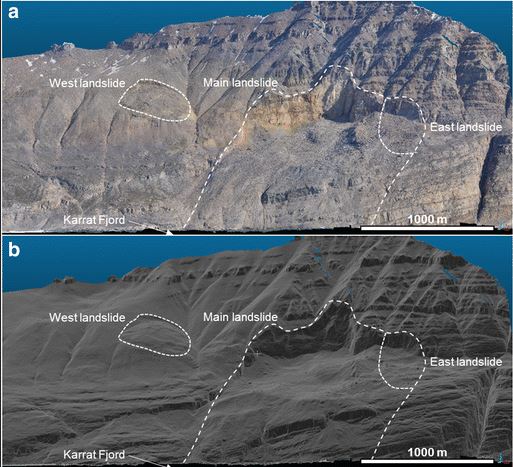4 January 2018
The Karrat Fjord rock avalanche: a new paper examining the 3D geometry
Posted by Dave Petley
The Karrat Fjord rock avalanche: a new paper examining the 3D geometry
The Karrat Fjord rock avalanche was the large, dramatic slope failure in Greenland in June 2017 that generated a localised tsunami, resulting in four deaths. I covered this extensively last year, in part because of the dramatic videos of the tsunami itself, and in part because of the interesting interpretations of seismic data associated with the landslide. We are now starting to see the first papers being published about this slide – I suspect we will see a number over the coming years. I have already highlighted one that examined precursory seismic activity. The journal Landslides has now published a paper (Gauthier et al. 2017) based upon a set of 3D reconstructions of the Karrat Fjord rock avalanche, constructed from aerial imagery collected by helicopter.
This study starts to provide some very helpful constraints on the landslide. The image below, from Gauthier et al. (2017) compares a conventional image with the 3D reconstruction:

Image from Gauthier et al. (2017) comparing conventional photography with the 3D reconstruction of the landslide scar for the Karrat Fjord rock avalanche.
.
The statistics for the Karrat Fjord rock avalanche are impressive. In total the team estimate that the landslide had a total volume of 58 million m³, of which 13 million m³ was deposited along the track and 45 million m³ entered the fjord. The landslide had a near vertical release plane at the rear, but was planar in terms of the sliding motion. The majority of the material travelled over 1000 m vertically, with a maximum fall height of 1270 m. In places that landslide was up to 300 m thick. They classify the landslide as a “tsunamigenic extremely rapid rock avalanche”, with the majority of the material entering the fjord in 2-3 minutes. It is unsurprising that a landslide on this scale was able to generate a local tsunami.
Gauthier et al. (2017) also comment upon the apparently incipient West Landslide, which can be seen in the image above. They note that this landslide first appeared after May 2015; to date it has moved about 50 m without failing catastrophically. Whilst this landslide appears to be shallower than the main slide, Gauthier et al. (2017) note that this needs further study. It is hard to disagree.
I think this is an important study that provides clarity about the nature of the important Karrat Fjord rock avalanche. I hope we will see further studies of the precursory development of the landslide, its motion, and the ways in which it generated the tsunami, in the months ahead. I know that a number of groups are working on this rock avalanche.
Reference
Gauthier, D., Anderson, S.A., Fritz, H.M. et al. 2017. Karrat Fjord (Greenland) tsunamigenic landslide of 17 June 2017: initial 3D observations. Landslides (2017). https://doi.org/10.1007/s10346-017-0926-4.


 Dave Petley is the Vice-Chancellor of the University of Hull in the United Kingdom. His blog provides commentary and analysis of landslide events occurring worldwide, including the landslides themselves, latest research, and conferences and meetings.
Dave Petley is the Vice-Chancellor of the University of Hull in the United Kingdom. His blog provides commentary and analysis of landslide events occurring worldwide, including the landslides themselves, latest research, and conferences and meetings.